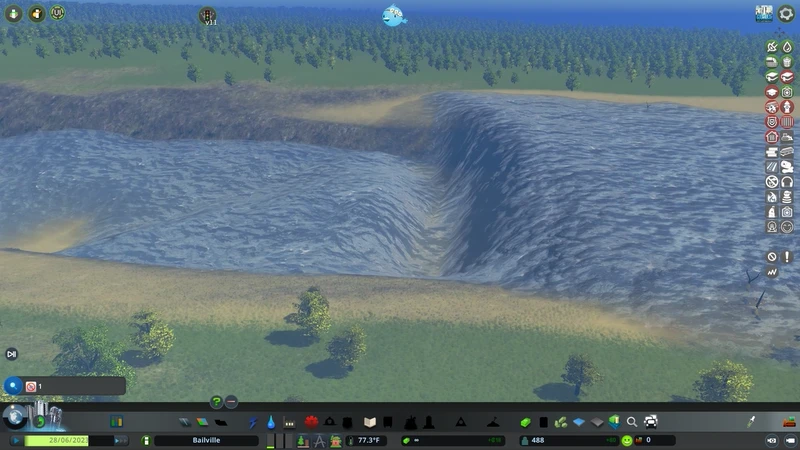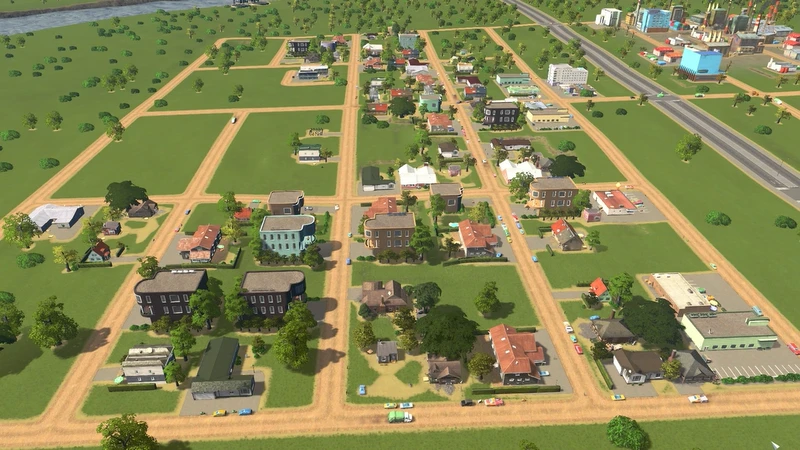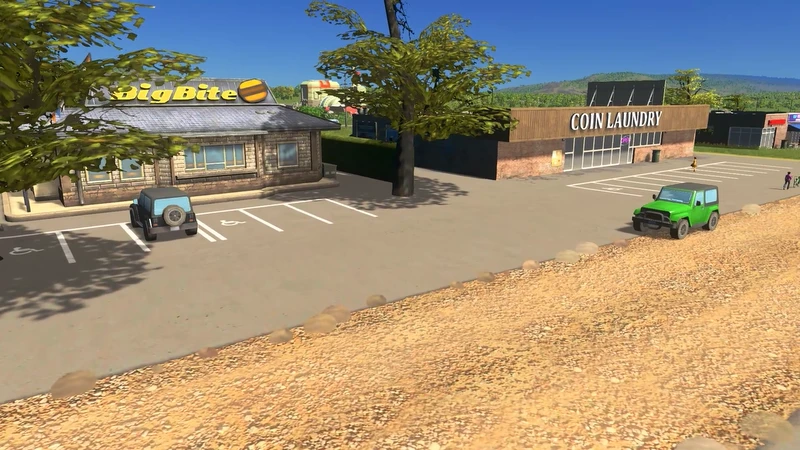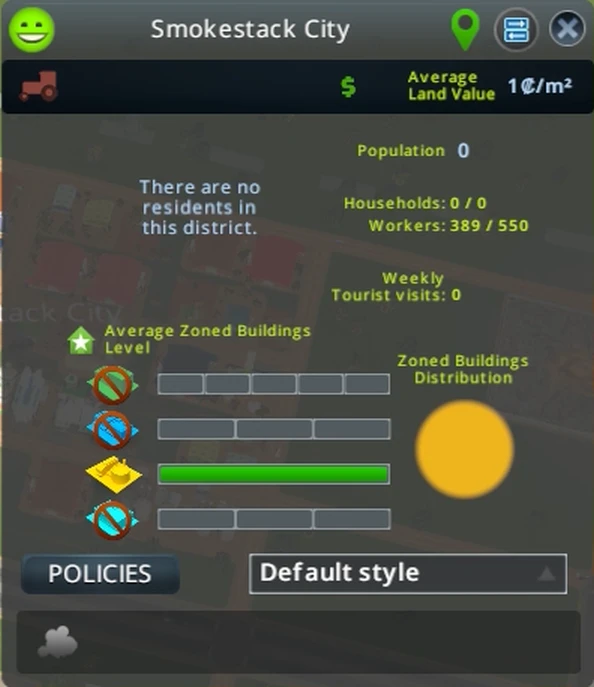Toggle Background Color
Minutes from the Bailville Planning Council Meeting, Nov. 27th, 2023
I know most of us are still busy processing the long weekend we just got off of, so I won't take up too much of your time. First of all, I hope everyone had a relaxing Thanksgiving weekend. I'm sure most of you saw the construction on your way into town this morning. We'll get to that at the end of the presentation. First, let's recap everything that happened since our last meeting.

Is there a fucking space in the middle of the name? I just noticed that in editing. 
After the first meeting, I submitted the name change paperwork and by the end of June, Dustberg had officially become Bailville.

Elisa Avenue was also officially renamed to Triumph Avenue.


I also ensured that Triumph Avenue stopped at the highway exits, which explains why it was named that Elisa Avenue in the first place. Some joker in the transportation office got mixed up and decided that the avenue went all the way to the highway itself.
I don't know what the tool itself is called, but it's a vanilla tool. You hit the green thing on the far right of the road view and you can tell the game exactly where a road starts and stops.

Finally, like I promised I would, I had crews downgrade the extraneous highways into regular one-way roads. All-in-all, the end of June was an incredibly busy time for the city!

Across the next several days, I had several engineers in my office trying to work out the best way to break up the grid. They had all sorts of ideas.

The faceted diamond was intriguing, but it had a veritable maze of streets inside. So we eventually discarded the idea.

One engineer thought we could shave off the tip of the diamond and create an envelope. There were still too many streets for my liking, and it would make walkability almost zero.

The idea isn't without merit. But it personally looks terrible. Where I wanted to put the pedestrian paths interfered with zoning on the diagonals. It was a mess! If we can work out the kinks, I want to use that pattern as the end of a neighborhood, with the highest value houses in the bottom-most bit. It would look rather nice in my opinion.

In the midst of all this planning and theorizing, we went ahead and turned Crescent Drive into Main Street. All the locals were already calling it that, and it's where all the shops are.

A small medical clinic was nestled onto an unused corner of Main Street.

Dolores, my poor secretary, was inundated with calls from thankful residents that day!

Another design for the trash pile. Nobody was happy with this one, as I recall.

Eventually we settled on squaring up the new row...

All things eventually come back to the grid, I fear. The start of the Education Park took shape on the left. That, at the very least, broke up the strict grid quite nicely.


More failed designs.

Most everyone in the office liked this layout. It didn't work for this specific area because of my walkability requirements. But we put this in our back pocket for a rainy day.

After several days of frustration, we finally decided to stick with old reliable. I don't plan to extend these two neighborhoods further south, so this strict grid pattern ends here.
New developments should have more interesting street layouts.

With the eastern part of the town situated, we bent a dirt road around the coal plant in preparation for the next phase of development. At the last meeting, the Council did not seem amenable to the incineration plant at this time, so we went with a more standard landfill-and-recycling center setup.

The recycling center's processing rate is too low to cover a town of even this tiny size. We tried it at first. The landfill was designated and then immediately closed. Within two months, the recycling center was almost at capacity. So we had to open the landfill back up.
We'll have to add additional landfills as the town expands. I'll keep an eye on it and let the Council know when that happens.
Basic incineration plants become available at, I believe, 7500 population. That... might be a long way off.

I glossed over it earlier, but the new elementary school was set up in an otherwise vacant 22x20 lot. I have big plans for this lot! For the time being, the children love to run around the field during recess, and more than one teacher was spotted, come the start of the new school year, teaching their class on blankets in the open field.

Finally, we instituted a flat tax rate of 12%. The citizens grumbled, but nobody left like they threatened to do.
12% is the point where citizens will still pay. 13% and over generally leads to residents leaving in droves.

The budget was not looking good when we implemented the new tax policy.

But within a few weeks, we were firmly in the black. This number only continued to climb for the remainder of the year. With one exception. I'll get to that shortly.

One day I was asked to take a small trip out of the town, but still in the region. We went down the Desire Path river to... I don't even know what to call this. It looks like a waterfall, right?

Well that water is flowing up. This is downstream. My civil engineers suggested that eventually the city could, at great expense, fix the problem by leveling out the riverbed. But this is miles outside of our sphere of influence.

The river flows no problem, but it does flood the local riverbanks constantly.

(Caption: Desire Path River, downstream from Bailville)
I... don't know.  It doesn't seem to hurt anything, but it's definitely a map maker's mistake. On a long enough timeline, we'll eventually need to take care of this. But it's a really, really long way away from the city.
It doesn't seem to hurt anything, but it's definitely a map maker's mistake. On a long enough timeline, we'll eventually need to take care of this. But it's a really, really long way away from the city.

(Caption: Bailville Aerial Shot, mid July 2023)

The town continued to develop until finally, in late August, I got a call from my bosses in the Capital.

They were happy with the progress of Bailville and gave a broad suite of authorizations.


Police and fire were two very big gains here. But the show stealer was districts. I'll explain why in a moment.

Our next goal was also passed along - 1400 population. That was another 500 residents past what we already had at the time. The carrot they dangled for this was parks and industry areas.

I wasted no time in painting several districts in the town. The first was over top of the industry area.

It was given a more fitting, and soon to be ironic, name.


Two more districts were painted over the two neighborhoods. The southern district, the first one designed, was called Old Town. The northern district, though just as aged as Old Town, was given the name Bail Heights.

The district menu lets us designate all sorts of things. It's one of the most widely-used menus in Cities: Skylines. To get started with most DLC packs, you usually need to paint a new special district.

Industry specializations are different from Industry Areas from the Industries DLC. Specializations are just a thing you drop onto an existing district. Here we're gonna take this farming specialization...

And click on Smokestack City!
Using executive fiat, I designated Smokestack City as agricultural industry. Overnight, the old polluting factories started shuttering one by one. Now, bear in mind, there's no fertile land anywhere near Smokestack City. But, in the absence of farmland to use, clean, food-related industries started popping up instead.

(Newspaper Clipping: Mayor Refuses Industrial Money)

Because of the intense ground pollution, land value was at an all-time low in Smokestack City. Most industrialists left, some immediately adapted to the new way of doing things. In fact, the first clean industry in the city was a butcher shop opened by one of the old guard taking advantage of the rock bottom land value.

(Newspaper Clipping: Council Bulldozers Evict Smokestack Barons)
The damage done to the land in a few short months was shocking.

Evicting the dirty industry also caused a dip in the city's cash flow. But it sorted itself out once the new, cleaner, workplaces moved in.

(Newspaper Clipping: Mayor Courting Pastoral Life)

Just like at the start of Bailville's life, it felt like every day there was a new business moving in. One day my office would approve the permit for a bakery, the next there was a cereal factory moving in next door. Fruit juicers set up shop next to butchers. It was definitely the high point of my year so far.

While all the business with Smokestack City was going on, I fast-tracked approval for not only a fire department, but also police as well.

Bailville's first fire department went at one terminus of main street...

While the police department went on the other.

Normal elementary schools can only support 300 students. The high capacity one handles 800! This is usually meant to go in a Plaza area, but they're really handy everywhere. Considering we only have 900 people in the city total, space for 800 kids is a bit overkill for the time being.

Community schools also exist, but they're rich-person versions of regular elementary schools. I don't expect I'm going to use these, except perhaps as flavor for an upper-class neighborhood somewhere.

A few basic public policies were also unlocked at 900 population. Smoke detectors are the most immediately useful.
My office also mandated smoke detectors be installed in every building in the city. We've all heard the tales of the out-of-control wildfires in Verde Beach across the country, and I don't want any part of that.


Energy and water meters are also available, if we so choose to make use of those in the future. Right now we're fairly comfortable in terms of both water and electricity supply.

While still waiting for Smokestack City to sort itself out, I also set a new district to its north for future use.


Because the city was in the middle of cleaning up at the time, I thought it might be interesting to set the new district to complement the increasingly-ironically named Smokestack City. Self-sufficient homes invite a more ecologically-minded citizenry to those districts. They don't have lawns, and they use solar to power their homes.

Naturally the area was given a pretty fitting name.

Moving on, by mid September, the recycling center was at almost 60% capacity, and so that's when we had to reopen the landfill.

That's also when I learned that my office had rubber stamped a permit for a pair of deranged individuals. They seemed content enough, however, and there were no complaints from the staff, so we decided to let them stay open for the time being.

You know, at first I was skeptical of this city-only instance of Chirpr. Then I saw messages like this pouring in and felt better about it. I'm glad to see that Pierce Phillips likes how I'm handling things!

I also know everyone is tired of holding these meetings at Jim's house. I have the plans for a Town Hall in my office, we just need to find a good location to build it.


It's huge. It would take up the majority of the space set aside for the Education Park. So we'll need to think carefully about where to build it.
This is a modded building. It's just a generic landmark that attracts tourists and has a small suite of cop cars to send out on patrol. But I like it for flavor because it makes sense that Bailville would have a Town Hall at around 900 population.

(Caption: Main Street Aerial View, Early October 2023)

(Caption: Bailville Aerial View, Early October 2023)

(Caption: Old Town, Early October 2023)

(Newspaper Clipping: Trick or Treat in Bailville? City Council Says Yes)

(Caption: BigBite Burgers, Early October 2023)

(Caption: Bail Heights, Early October 2023)


In October, things were looking pretty good in Bailville. Bail Heights and Old Town both were neck-in-neck for land value. The elementary school gave Bail Heights a boost in average land value, one which will only grow larger as more gets added to the mostly-empty park.

Land value in Smokestack City was as low as it was possible to get. The damage wrought by the old pollution barons can't be understated. $0.01/m² is utterly ridiculous.

On the other hand, in three months, a lot of the soil pollution had been cleared up. So while the land value is at rock bottom, in the immortal words of Wynonna Judd, rock bottom is good, solid ground.

In less good news, the emergency services coverage had me worried.


Two more fire stations were built. One was placed near the coal power plant, while the other was placed over in Old Town.

22% hazard is a number I can live with. Above 40 was far too high. Most of that hazard number is trees, which our current departments can't service. We would need a helicopter depot to reach them.
That's also region-wide. Every tree not covered by a fire watch tower, which we can't even build, counts against our fire safety score. It's a tad ridiculous like that. With every building in the city covered by a fire department, outside of the riverfront utilities campus, I'm happy.

Garbage processing isn't as great as it could be. But the expense to stay ahead of the flood of garbage is far too high, both in terms of capital as well as land. Currently, the recycling center works in conjunction with the Bailville Service Authority. It doesn't handle all of the town's trash, but it blunts the flow enough to keep the landfill mostly empty.
The city is still growing at a rapid pace, and we already need another recycling center to even be in the green in terms of processing. To stay ahead of the curve, we would need to build two or three per thousand population. So I'm not going to worry about garbage processing until we have incinerators online. Until then, we can slap down more landfills if needed.

Traffic flow is fantastic. The busiest intersection is right in the middle of town, which stands to reason. It might become a problem in the future, but overall flow at 90% is a reason to celebrate.

On my way into work one morning it struck me that the town had no signage whatsoever. So we fast-tracked some stop signs to prioritize the flow of traffic. Cars moving onto or off of Triumph need to wait their turn, while through traffic is given right-of-way.

I feel kinda dumb for forgetting to set signs up. Thankfully the game doesn't model traffic accidents or we'd have had problems!

One of the engineers came up with a rather fetching design for Granola Square - now renamed Granola Court.


Even though Smokestack City is much cleaner, it's still zoned industrial. So we put a small barrier of organic and local produce commercial to try and dampen the sound a little. It's not perfect, but it'll have to do.

(Caption: Granola Court, mid November 2023)

(Caption: Bailville, Thanksgiving 2023)

(Caption: Old Town, Thanksgiving 2023)

(Caption: Smokestack City, Thanksgiving 2023)

(Caption: Granola Court, Thanksgiving 2023)

Imagine my surprise when I sat down with the family to eat Thanksgiving Dinner and I got a call from the Capital, congratulating Bailville on reaching its population goal.
1400 is the first big population milestone. A lot of cool shit unlocks!

Landscaping unlocks, which means we can edit terrain. Industry areas unlock, so we can actually build a real forestry (or agriculture) industry. We can build giant parks, we can build small parks. We can set up a fishery!

Because we have like three new district types, there's a bunch of policies that only can apply to them.
We also have new road types, quays, fences, and so, so, so many parks. In the middle of the giant list of buildings are also these two...


The library is nice, but the real prize is the high school. Once we slap that down, we can start educating our citizens enough that they don't want to work in shitty industry jobs like we just kicked out.

They're mostly for looks, but we also unlock some parking lots I have in the mod list.

Our next goal is 2600 population. The big carrot they're offering us is mass transit. So we'll want to get there sooner rather than later. We'll be able to employ buses, trams, and taxis when we do!

For this next phase of development, we'll need to expand the city's borders. If we want to expand north or west, we'll have to cross the Desire Path, so I would prefer if we moved east or south instead.


(Caption: Bailville visible behind the hill)
To the East the land is dominated by a fairly shallow hill. If we expanded this direction, we would need to grade off the top in order to have flat enough land to build on. This isn't a huge problem.

(Caption: Bailville visible in the distance)
To the South the land is much flatter and, while there are trees, there is acre after acre of fertile meadowland. It would be an ideal spot to build an industrial agricultural operation.


Just to be sure all options are on the table, to the West across the river, the land is dominated by a mountain. There is a lot of valuable ore in that mountain, but we would need to do extensive grading to make the land usable. We also do not currently have the ability to set up an industrial mine in any capacity.

While you all consider how we might expand, let me quickly finish my presentation. On Black Friday, I ordered a high school be built next to the elementary school.

I also ordered my gravel paths finally installed.

It looks a lot nicer when the roads are all paved, trust me.

In order to facilitate pedestrian movement, I also started the construction project I'm sure you all have been wondering about.

It's a series of elevated walkways. Residents can walk up the gravel paths from their homes, get up on an elevated path on Main Street, and cross Triumph Avenue without having to worry about getting run over in traffic.

(Caption: The view above Triumph Avenue, November 27th, 2023)

Anyway, I need some direction on how to proceed from here. In addition to which parcel of land to buy, I need to know do we build a city park or a campground? And where. And also do we go with a lumber mill or an industrial farm? However, because industry demand is limited until we have a larger population, by necessity we can only support one industrial area. So we have to choose between lumber and agriculture, not both.
With that being said, there's no reason we can't buy the southern bit of land and just plant enough trees to make a lumber mill down there. And there is fertile farmland to the east. So don't worry that picking a new plot of land will necessarily pick which industry we go with.
Lastly, where do we build the town hall?
We can also technically build a city zoo and a theme park, but both are somewhat inappropriate for such a small town. And fishing industry is technically available, but it would cannibalize the extremely limited industrial demand. I also think if we wanted to do that, we would want to put it down in the bay far off to the west.
Also, strictly speaking, I can make the RICO demand whatever I want because I have the DemandController mod. But I think it's more fun to grow the city organically without it.
Thank you for your patience, and I'd like to now open up the floor for questions and comments.






























 It doesn't seem to hurt anything, but it's definitely a map maker's mistake. On a long enough timeline, we'll eventually need to take care of this. But it's a really, really long way away from the city.
It doesn't seem to hurt anything, but it's definitely a map maker's mistake. On a long enough timeline, we'll eventually need to take care of this. But it's a really, really long way away from the city.


















































































